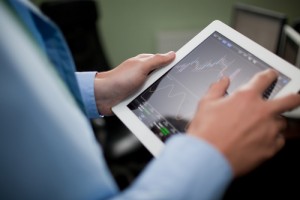 There are two popular methods of trading forex: trading the trend and trading in a range. Which is for you? That depends. Both have their advantages and drawbacks. What you really have to ask yourself is what kind of trader you want to be.
There are two popular methods of trading forex: trading the trend and trading in a range. Which is for you? That depends. Both have their advantages and drawbacks. What you really have to ask yourself is what kind of trader you want to be.
Trading The Trend
When you trade on the trend, you’re trading on the general movement of the forex market. A forex trading broker usually helps you by providing leverage borrowed money that you can use to trade with. In forex, it’s typical to see leverage of 100:1, meaning that for every £1 you have, you can trade £100. Compare this to the stock market. In the stock market, you’re often limited to a 50 percent margin, or 1.5:1 trading. That means for every £1 you have in your trading account, you can only trade with £1.50.
When using the trend, it’s not unusual to see wild swings in a trader’s account. For example, you may start out with £10,000 in your trading account and double it within a few short months. Even if you’re setting a strict stoploss of 20 pips, you can still make a lot of money.
The problem is keeping that money. Few traders have the mental discipline to take stop losses continuously. Most traders become frustrated and give up, or get emotional about the market, and end up losing a lot of money.
This is when leverage becomes dangerous. In trend trading, you can be stopped out before you’re able to make a profit, and thus you may end up on the wrong end of a margin call owing more than you came to the table with. It’s not a good position to be in. No one likes being in debt over trading losses.
Range Traders
Range traders are a bit different from tend traders. In range trading, you’re not so concerned about the trend. Instead, what you hope is that the market swings around a lot and then reverts to its original starting position.
This is sometimes called “rangebound trading.” The underlying assumption in range trading is that, regardless of the initial direction of the trend, the market will end up coming back to the beginning eventually. And, the range trader’s job is to capture the profits between now and the time the market does return to its starting position.
All of the oscillations of the market represent profit opportunities. In range trading, you do not necessarily want to be correct about your initial assumptions about the trend. In fact, it can be helpful to be wrong about them completely.
Let’s say that the EUR/USD is trading at 1.5000. You, as the range trader would want to short the pair at that price and every 20 or 50 pips higher. Then, you would buy it back as it moves every 25 pips down. The assumption here is that, eventually, the currency pair will revert to its starting position 1.5000. You profit as it “falls back to earth.”
However, a major disadvantage to this trading strategy is that you need to be wellcapitalised. Ifyou do not have a large bankroll, you may end up being stopped out before you make a profit. Fortunately, a lot of brokers have solved with problem by providing traders with mini lots of 10,000 as opposed to the 100K lots. In a 10K lot, each pip is only worth £1 instead of £10, and you can trade in either 1,000 or 100 pip increments. That means when you do experience a drawdown, it’s not as bad.
Which Is Best For You?
The type of trading that’s right for you depends on your goals. With trend trading, you have to be committed to the trade, and you cannot be afraid of momentary setbacks. Really, you need to walk into the trade with the idea that, on the average, you should be winning.
You’re going to experience drawdowns. It happens to everyone. You cannot get emotional about it. Set your stop loss and forget about the trade. Let it ride its course.
With range trading, your biggest roadblock will be having the bankroll to make this strategy worthwhile. In many cases, this means having about £10,000 or more sitting in your account. Why this much? Because most traders won’t be trading with more than 1 to 2 percent of their total savings that means you shouldn’t trade with more than £200 out of your £10,000.This is a sufficient margin of safety to protect you from significant drawdowns that force a margin call. It also gives you room to slightly increase or decrease your trading capital if you want or need additional funds or you want to pull back and trade more conservatively. Both trading styles have their time and place, and you don’t have to pigeonhole yourself into one or the other. Try both, and see which one you like best.
Logan Francis is always looking for new ways to trade in the Forex market. An avid blogger, you can find his interesting and helpful articles on many finance and Forex trading blog sites.


Traders are instrumental in financial markets, actively participating in buying and selling assets to navigate market trends. Equipped with analytical skills, traders deploy strategies such as technical analysis and risk management. Success in trading https://www.linkedin.com/pulse/pocket-option-review-2024-can-broker-trusted-traders-union-com-kdcmc/ demands adaptability, discipline, and a comprehensive understanding of global events. Traders stay vigilant, continuously monitoring economic indicators to make informed decisions, seize opportunities, and proficiently manage risks in the ever-evolving landscape of finance.